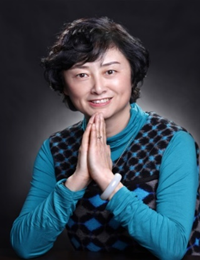JIN Ying

JIN Ying
Ph.D., Principal Investigator.
E-mail: yjin@sibs.ac.cn
Tel: 86-21-63846590-776520
Laboratory of Pluripotent Stem Cell & Developmental Biology
Research Field: Over the years, Jin lab has focused on the self-renewal and differentiation regulatory mechanism of pluripotent stem cells, especially human embryonic stem cells, and is committed to revealing signaling pathways, transcription factors and epigenetic regulatory factors that ensures the infinite self-renewal of embryonic stem cells, aiming to optimize the in vitro culture system of human embryonic stem cells and lay the foundation for obtaining functional cells essential for clinical treatment.
Personal Introduction
Educational background
1978-1983: M.D. China Medical University,
1983-1988: Ph.D. Peking Union Medical College (PUMC) and Chinese Academy of Medical Science (CAMS)
Representative research carrier or other carrier
10/1988-9/1994: Postdoctoral fellow, Department of Pharmacology, The University of North Texas Health Science Center, Fort Worth, Texas
9/1994-9/1998: Research fellow, Molecular Immunology Center, Department of Microbiology University of Texas Southwestern Medical Center, Dallas, Texas
10/1999-5/2002: Researcher, Developmental Biology Research Laboratory of Shanghai JiaoTong University School of Medicine, Shanghai, China
4/2002 to present: Principal Investigator of Stem Cell Research Group in Shanghai Institutes of Biological Sciences, Chinese Academy of Sciences, China
6/2002-5/2017: Director of Molecular Developmental Biology Department of Shanghai JiaoTong University School of Medicine, Shanghai, China
3/2006-3/2017: Director of Key Laboratory of Stem Cell Biology, Chinese Academy of Sciences
6/2017 -11/2021: Chair, Department of Histoembryology, Genetics and Developmental Biology in Shanghai JiaoTong University School of Medicine, Shanghai, China
12/2021 to present: Principal Investigator of Department of Histoembryology, Genetics and Developmental Biology in Shanghai JiaoTong University School of Medicine, Shanghai, China.
Publications
Liu Y, Wang H, Shao M, Jin Y* and Liao B*. (2022) The functional role of OGDH for maintaining mitochondrial respiration and identity of primed human embryonic stem cells. Biochem Biophys Res Commun. 612:30-36.
Xin C, Zhu C, Jin Y* and Li H*. Discovering the role of VEGF signaling pathway in mesendodermal induction of human embryonic stem cells. Biochem Biophys Res Commun. 2021; 553:58-64.
Chen H, Zeng Y, Shao M, Zhao H, Fang Z, Gu J, Liao B and Jin Y*. Calcineurin A gamma and NFATc3/SRPX2 axis contribute to human embryonic stem cell differentiation. J Cell Physiol. 2021; 236(8):5698-5714.
Liu X, Fang Z, Wen J, Tang F, Liao B, Jing N, Lai D* and Jin Y*. SOX1 is required for the specification of rostral hindbrain neural progenitor cells from human embryonic stem cells. iScience. 2020; 23(9):101475.
Ding J, Fang Z, Liu X, Zhu Z, Wen C, Wang H, Gu J, Li QR, Zeng R, Li H and Jin Y*. CDK11 safeguards the identity of human embryonic stem cells via fine-tuning signaling pathways. J Cell Physiol. 2020; 235(5):4279-4290.
Fang Z, Liu X, Wen J, Tang F, Zhou Y, Jing N and Jin Y*. SOX21 Ensures Rostral Forebrain Identity by Suppression of WNT8B during Neural Regionalization of Human Embryonic Stem Cells. Stem Cell Reports. 2019; 13(6):1038-1052.
Hu J, Li S, Sun X, Fang Z, Wang L, Xiao F, Shao M, Ge L, Tang F, Gu J, Yu H, Guo Y, Guo X, Liao B* and Jin Y*. Stk40 deletion elevates c-JUN protein level and impairs mesoderm differentiation. J Biol Chem. 2019; 294(25):9959-9972.
Li S, Xiao F, Zhang J, Sun X, Wang H, Zeng Y, Hu J, Tang F, Gu J, Zhao Y, Jin Y* and Liao B*. Disruption of OCT4 Ubiquitination Increases OCT4 Protein Stability and ASH2L-B-Mediated H3K4 Methylation Promoting Pluripotency Acquisition. Stem Cell Reports. 2018; 11(4):973-987.
Xu Y, Luo X, Fang Z, Zheng X, Zeng Y, Zhu C, Gu J, Tang F, Hu Y, Hu G, Jin Y* and Li H*. Transcription coactivator Cited1 acts as an inducer of trophoblast-like state from mouse embryonic stem cells through the activation of BMP signaling. Cell Death Dis. 2018; 9(9):924-940.
Zhao H and Jin Y*. Signaling networks in the control of pluripotency. Current Opinion in Genetics & Development 2017; 46:141-148.
Li T, Zhao H, Han X, Yao J, Zhang L, Guo Y, Shao Z, Jin Y* and Lai D*. The spontaneous differentiation and chromosome loss in iPSCs of human trisomy 18 syndrome. Cell Death Dis. 2017; 8(10):e3149.
Xiao F, Liao B, Hu J, Li S, Zhao H, Sun M, Gun J and Jin Y*. Jmjd1c Ensures Mouse Embryonic Stem Cell Self-renewal and Somatic Cell Reprogramming through Controlling MicroRNA expression. Stem Cell Rep. 2017; 9(3):927-942.
Wang L, Yu H*, Cheng H, He K, Fang Z, Ge L, Cheng T and Jin Y*. Deletion of Stk40 impairs definitive erythropoiesis in the mouse fetal liver. Cell Death Dis. 2017; 8(3):e2722.
Wen J, Zeng Y, Fang Z, Gu J, Ge L, Tang F, Qu Z, Hu J, Cui Y, Zhang K, Wang J, Li S, Sun Y and Jin Y*. Single-cell analysis reveals lineage segregation in early post-implantation mouse embryos. J BiolChem. 2017; 292(23):9840-9854.
Zhao H, Han Z, Liu X, Gu J, Tang F, Wei G and Jin Y*. The chromatin remodeler protein Chd4 maintains embryonic stem cell identity by controlling pluripotency- and differentiation-associated genes. J BiolChem. 2017; 292(20):8507-8519.
Zhu Z, Li C, Zeng Y, Ding J, Qu Z, Gu J, Ge L, Tang F, Huang X, Zhou C, Wang P, Zheng D and Jin Y*. PHB associates with the HIRA complex to control an epigenetic-metabolic circuit in human ESCs. Cell Stem Cell. 2017; 20(2):274-289.
He K, Hu J, Yu H, Wang L, Tang F, Gu J, Ge L, Wang H, Li S, Hu P and Jin Y*. Serine/threonin kinase 40 (Stk40) functions as a novel regulator of skeletal muscle differentiation. J BiolChem. 2017; 292(1):351-360.
Yang J, Zhao H, Ma Y, Shi G, Song J, Tang U, Li S, Li T, Liu N, Tang F, Gu J, Zhang L, Zhang Z, Zhang X, Jin Y* and Le W*. Early pathogenic event of Alzheimer’s disease documented in iPSCs from patients with PSEN1 mutations. Oncotarget. 2017; 8(5):7900-7913.
Li C, Ma Y, Zhang K, Gu J, Tang F, Chen S, Cao L*, Li S* and Jin Y*. Aberrant transcriptional networks in step-wise neurogenesis of paroxysmal kinesigenic dyskinesia-induced pluripotent stem cells. Oncotarget. 2016; 7(33):53611-53627.
Liu J, Luo X, Xu Y, Gu J, Tang F, Jin Y* and Li H*. Single-stranded DNA binding protein Ssbp3 induces differentiation of mouse embryonic stem cells into trophoblast-like cells. Stem Cell Res Ther. 2016; 7(1):79-93.
21)Zheng S, Sun M, Zhang K*, Gu J, Guo Z, Tian S, Zhai G, He X, Jin Y* and Zhang Y*. Profiling post-translational modifications of histones in neural differentiation of embryonic stem cells using liquid chromatography-mass spectrometry. J Chromatogr B. 2016; 1017:36-44.
Zhou C, Yang X, Sun Y, Yu H, Zhang Y* and Jin Y*. Comprehensive profiling reveals mechanisms of SOX2-mediated cell fate specification in human ESCs and NPCs. Cell Res. 2016; 26(2):171-189.
Sun M, Liao B, Tao Y, Chen H, Xiao F, Gu J, Gao S and Jin Y*. Calcineurin-NFAT Signaling Controls Somatic Cell Reprogramming in a Stage-Dependent Manner. J Cell Physiol 2015; 231(5):1151-1162.
Qu Z, Guan Y, Cui L, Song J, Gu J, Zhao H, Xu L, Lu L, Jin Y* and Xu G*. Transplantation of rat embryonic stem cell-derived retinal progenitor cells preserves the retinal structure and function in rat retinal degeneration. Stem Cell Res Ther. 2015;6:219-237.
Yu H, HeK, Wang L, Hu J, Gu J, Zhou C, Lu R and Jin Y*. Stk40 represses adipogenesis through translational control of CCAAT/enhancer-binding proteins. J Cell Sci. 2015; 128(15): 2881-2890.
Zhu L, Zhang S and Jin Y*. (2014) Foxd3 suppresses NFAT-mediated differentiation to maintain self-renewal of embryonic stem cells. EMBO Rep. 15: 1286-96.
Wei Z, Sun M, Liu X, Zhang J and Jin Y*. (2014) Rufy3, a protein specifically expressed in neurons, interacts with actin binding protein Fascin to control the growth of axons. J Neurochem. 130(5):678-692.
Luo X, Wang B, Tang F, Zhang J, Zhao Y, Li H* and Jin Y*. (2014) Wwp2 targets SRG3, a scaffold protein of the SWI/SNF-like BAF complex, for ubiquitination and degradation. Biochem Bioph Res Co. 443(3):1048-1053.
Guan Y, Cui L, Qu Z, Lu L, Wang F, Wu Y, Zhang J, Gao F, Tian H, Xu L, Xu G, Li W*, Jin Y* and Xu G*. (2013) Subretinal transplantation of rat MSCs and erythropoietin gene modified rat MSCs for protecting and rescuing degenerative retina in rats. Curr Mol Med. 13(9):1419-1431.
Yang H, Liu Z, Ma Y, Zhong C, Yin Q, Zhou C, Shi D, Cai Y, Zhao H, Wang H, Tang F, Wang Y, Zhang C, Lai D, Jin Y*, Sun Q* and Li J*. (2013) Generation of haploid embryonic stem cells from Macaca fascicularis monkey parthenotes. Cell Res. 23(10):1187-1200.
Zhou Y, Jiang H, Gu J, Tang Y, Shen N and Jin Y*. (2013) MicroRNA-195 targets ADP-ribosylation factor like protein 2 inducing apoptosis in human embryonic stem cell-derived neural progenitor cells. Cell Death Dis. 4:e695-706.
Cui L, Guan Y, Qu Z, Zhang J, Liao B, Ma B, Qian J, Li D, Li W, Xu G* and Jin Y*. (2013) Wnt signaling determines tumorigenicity and function of ESC-derived retinal progenitors. J Clin Invest. 123(4):1647-1661.
Liao B, Zhong, X, Xu H, Xiao F, Fang Z, Gu J, Chen Y, Zhao Y and Jin Y*. (2013) Itch, an E3 ligase of Oct4, is required for embryonic stem cell self-renewal and pluripotency induction. J Cell Physiol. 228(7):1443-1451.
Yu H, He K, Li L, Sun L, Tang F, Li R, Ning W and Jin Y*. (2013) Deletion of Stk40 in the mouse causes respiratory failure and death at birth. J Biol Chem. 288(8):5342-5352.
*Corresponding Author




